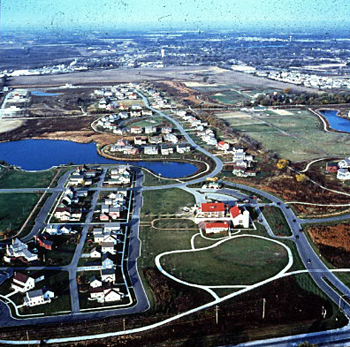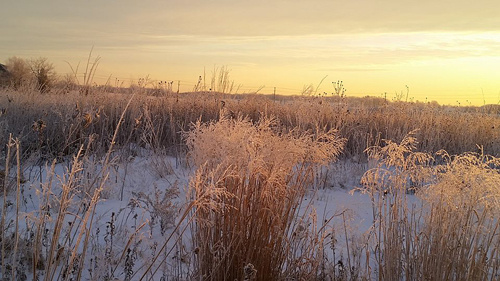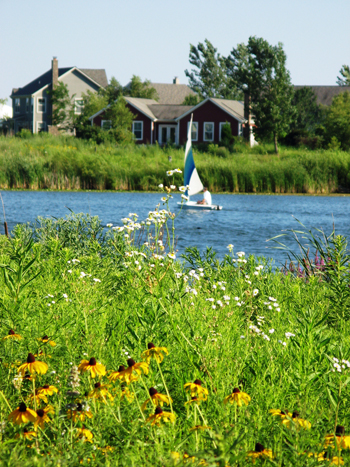History
Prairie Crossing was built to preserve open land – by developing it. In the 1970s a large developer announced aggressive plans for thousands of conventional housing units on the 675 acres where Prairie Crossing stands today. Neighboring families feared that such suburban sprawl would destroy the rural landscape they loved in the heart of Lake County. After more than fifteen years of legal battles these neighbors, led by Gaylord Donnelley, asked George and Vicky Ranney to negotiate a land purchase, settle the litigation, and prepare a land use plan that eventually developed as Prairie Crossing.
Overview
 Prairie Crossing is a master-planned conservation community, and one of the first modern developments in the country planned with a working organic farm. The initial vision for the community was generated by a group of neighboring landowners committed to the conservation of the rural character of the area east of Prairie Crossing, which included wetlands, woods, rolling farmland, and farmhouses.
Prairie Crossing is a master-planned conservation community, and one of the first modern developments in the country planned with a working organic farm. The initial vision for the community was generated by a group of neighboring landowners committed to the conservation of the rural character of the area east of Prairie Crossing, which included wetlands, woods, rolling farmland, and farmhouses.
In the 1970s a large developer announced aggressive plans to build thousands of housing units on the land that eventually became Prairie Crossing. This proposed large dense development project was objected to by many parties and became the subject of legal battles that ended after 15 years with the Heartland Settlement.
Conservationists Gaylord and Dorothy Donnelley bought the property in 1987. They formed Prairie Holdings Corporation with a group of neighbors and asked George and Vicky Ranney to develop the land, hoping to provide an alternative to the prevailing pattern of suburban sprawl. The Ranneys assembled a planning team and began developing the community in 1992, based on 10 Guiding Principles.
One hundred acres of this land was reserved for the Prairie Crossing Farm, a working organic farm which is protected by a conservation easement. Eventually, ownership of the farmland was transferred from Prairie Holdings Corporation to the Liberty Prairie Foundation, a 501(c)(3) private operating foundation.
Timeline
- 1972 – 2,200 acre high-density residential, commercial and industrial development proposed including 2,400 housing units on 668 acres of land
- Oct. 1986 – 14 years of state and federal lawsuits against this dense proposed development settled in the Heartland Settlement
- Nov. 1987 – Conservationists Gaylord and Dorothy Donnelley bought the property that would eventually become Prairie Crossing
- 1991 – Initial master plan for the Liberty Prairie Reserve (initially named the Oak Prairie Open Space Preserve) created
- 1992 – Prairie Holdings Corporation formed, comprised of the Donnelleys and 7 families with land holdings in the area
- Apr. 1992 – Gaylord Donnelley died and George Ranney Jr. (Donnelley’s nephew) named President of Prairie Holdings
- 1992 – The Ranneys assembled an initial planning team and began developing Prairie Crossing based on 10 Guiding Principles
- 1993 – Liberty Prairie Foundation formed as a separate entity from Prairie Holdings Corporation
- Apr. 1993 – Final permits received for Prairie Crossing development
- 1993 – First farmer, Alvin Warren, began farming at the Prairie Crossing Farm under management by Prairie Holdings Corporation
- 1994 – Prairie Crossing Farm sold first Community Supported Agriculture (CSA) program
- Dec. 1994 – First Prairie Crossing home closed, and first resident moved into the development
- 1995 – Tom and Deni Peterson began farming the Prairie Crossing Farm under management by Prairie Holdings Corporation
- 1996 – Prairie Crossing became first community-scale Building America project in the country
- June 1996 – Prairie Crossing Stable Cooperative opened
- Aug. 1996 – Byron Colby Barn reconstructed in Prairie Crossing
- Aug. 1996 – First Prairie Crossing Metra stop inaugurated
- Jul. 1998 – Phase 2 of Prairie Crossing development permitted
- Oct. 1998 – Sanctuary Pond became a sanctuary for threatened & endangered fish species
- Aug. 1999 – Phase 3 of Prairie Crossing development permitted
- Sept. 1999 – First class started at the Prairie Crossing Charter School
- June 2000 – Phase 4 of Prairie Crossing development permitted
- 2001 – John Demaree began farming the Prairie Crossing Farm under management by Prairie Holdings Corporation
- Jul. 2002 – Transition team, including 21 residents, formed to transfer governance of Prairie Crossing from Prairie Holdings Corporation to the homeowners
- Dec. 2002 – Prairie Crossing Homeowners Association assumed management responsibilities of the neighborhood
- 2002 – Dave Konrad began farming the Prairie Crossing Farm under management by Prairie Holdings Corporation
- Apr. 2003 – Phase 5 of Prairie Crossing development permitted
- Oct. 2003 – Montessori School of Lake Forest Adolescent Program opened at the Prairie Crossing Farm
- Apr. 2004 – Matt & Peg Shaeffer (Sandhill Organics) began farming the Prairie Crossing Farm as a for-profit independent farm business
- Apr. 2004 – Second Prairie Crossing Metra stop inaugurated
- July 2004 – Station Square permitted
- 2005 – Farm-based education begins at the Prairie Crossing Farm with the MSLF Adolescent Program and the Prairie Crossing Charter School
- 2005 – Farm Business Development Center began at the Prairie Crossing Farm
- Nov. 2006 – Grand opening of the Shops at Station Square retail space in Prairie Crossing
- Dec. 2005 – Last single family home sold by Prairie Holdings Corporation
- Feb. 2006 – First condo sold by Prairie Holdings Corporation
- 2010 – LEED certification for Prairie Crossing condo development
- 2010 – Building Communities with Farms report published
- 2011 – Prairie Holdings Corporation sold remaining condos
- 2012 – Jen & Jeff Miller become resident farmers and farm the Prairie Crossing Farm as a for-profit independent farm business
- 2014-2015 – Prairie Crossing celebrated 20th anniversary of the first Prairie Crossing home
Key Lessons
 Prairie Crossing celebrated the 20th anniversary of the first Prairie Crossing home in 2015. This anniversary elicited the following reflections on the key lessons learned from Vicky and George Ranney, co-developers of Prairie Crossing. Click here to read George and Vicky’s key lessons for others contemplating a development similar to Prairie Crossing.
Prairie Crossing celebrated the 20th anniversary of the first Prairie Crossing home in 2015. This anniversary elicited the following reflections on the key lessons learned from Vicky and George Ranney, co-developers of Prairie Crossing. Click here to read George and Vicky’s key lessons for others contemplating a development similar to Prairie Crossing.
In 2010 a group of developers, architects, and farmers gathered at the Byron Colby Barn in Prairie Crossing to talk about their designs for incorporating agriculture into new communities and how they have worked. They discussed varioius models and the benefits and challenges of this type of development, which is sometimes referred to as agricultural urbanism. Click here to read Mike Sands’ observations on putting intent into practice.
Message from the Urban Land Institute
 Farm-centric communities have been getting a lot of attention lately. Articles in the New York Times, Wall Street Journal, and other publications have been showcasing new developments that include agriculture at their core. However, the precursor and prototype for all of these communities is Prairie Crossing in Grayslake, Illinois. Prairie Crossing was one of the first large developments that proved that developing in harmony with the land could be good for both the pocketbook and the land.
Farm-centric communities have been getting a lot of attention lately. Articles in the New York Times, Wall Street Journal, and other publications have been showcasing new developments that include agriculture at their core. However, the precursor and prototype for all of these communities is Prairie Crossing in Grayslake, Illinois. Prairie Crossing was one of the first large developments that proved that developing in harmony with the land could be good for both the pocketbook and the land.
Prairie Crossing changed the paradigm of suburban development. Instead of carving up a century-old farm into cookie-cutter house lots and streets, Prairie Crossing restored the native prairie and the original barn, started a 100-acre organic farm, and took a natural approach to stormwater management, all while accommodating hundreds of new high-performance homes, and award-winning school, along with new stores and transit stations.
Prairie Crossing proved that developers and environmentalists could find common ground. It also proved that it was possible for a new community to work with nature, not against it. Prairie Crossing is a landmark community not only because it saved open space, reduced infrastructure costs, increase property values, fostered sustainable agriculture and preserved rural character, but also because it has spawned a new generation of families and children living in harmony with the land.
I wish to offer my hearty congratulations to George and Vicky Ranney and to all the others who played a role in developing this visionary and remarkable community.
Ed McMahon
Edward T. McMahon is Senior Resident Fellow and Charles Fraser Chair for Environmental Policy at the Urban Land Institute (ULI), the foremost association of real estate and land use professionals in the country. He leads the ULI’s worldwide efforts to conduct research on sustainable development. He is the author of 15 books and over 300 articles. His most recent book is Conservation Communities: Creating Value with Nature, Open Space and Agriculture. He has worked with more than 600 communities in all 50 states in a wide variety of land use issues.
 Prairie Crossing
Prairie Crossing